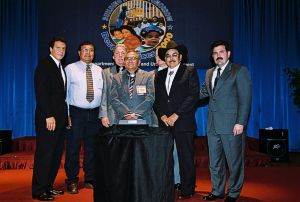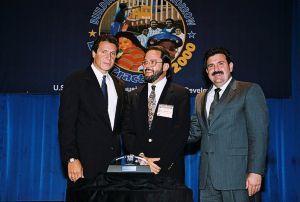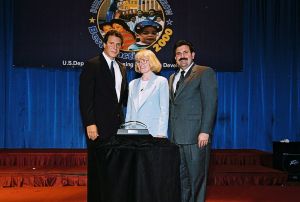 |
2000 Best Practice Awards
Best of the Best Winners: Arizona
Best Practice: Rio Puerco Acres
RIO PUERCO ACRES GETS A FACE LIFT
Fort Defiance, Arizona. Walls lacking insulation, flat roofs that sagged with
rain, poorly laid foundations of homes near almost impassible roads—all
were characteristic of the former 86-unit Rio Puerco Acres in Arizona. The
revived Rio Puerco Acres consist of 100 new, single-family homes on tribal
lands held in trust for the Navajo Nation. These energy-efficient, three-
and four-bedroom homes replace the structurally deteriorating 28-year-old
multifamily development.
Successful demolition, new construction, resident
relocation and occupancy of the new homes resulted from a partnership |

Benjamin Price/Everett Ross/Chester Karl/Bill
Aubrey/Jimmy Visu/Jorald Fritz receiving Best of the Best award from Secretary
Cuomo (l) and Deputy Secretary Ramirez (r) |
of three federal funding agencies, private
lenders, the nonprofit Fort Defiance Housing Corporation and the Navajo
Housing Authority. The new low-income housing will be converted to homeownership
in 30 years once the mortgage is paid.
The Navajo Housing Authority and the Fort
Defiance Housing Corporation formed a nonprofit organization to serve as
owner of the HUD-subsidized original Rio Puerco Acres. The partnership allowed
the housing authority to receive approximately $7.6 million in Native American
Housing Assistance and Self-Determination Act (NAHASDA) grant funds. This
funding was then leveraged for an additional $3.8 million in mortgage financing
insured by the U.S. Department of Agriculture (USDA) and guaranteed loans
from private institutions. A state bank provided a $2 million interim construction
loan that will be repaid from a USDA guaranteed permanent mortgage.
The Fort Defiance Housing Corporation created its own second-ary source
of funding from the state bank in conjunction with the Federal Home Loan
Bank to provide money for interim financing. USDA’s Rural Housing Service
and the Federal Home Loan Bank provided additional interim and gap financing.
In an area where unemployment hovers between
60 and 70 percent, the project has provided 50 full-time construction jobs
and positions for four families in long-term maintenance and management
of the project.
The project will provide a $4 million payroll that will offset the economic
deterioration of the impoverished community of Fort Defiance.
To overcome the lapse in resident’s rental
subsidies that would occur with the razing of the original Rio Puerco Acres,
the HUD Arizona office partnered with the City of Winslow Housing Authority
to administer tenant-based Section 8 vouchers when the project-based Housing
Assistance Payment Contract expired with the property’s demolition.
Nearly half of all homes on the Navaho Nation
lack full kitchen plumbing, and as many as three generations live together
in small spaces. Unfortunately, the need for quality housing does not always
match resources, especially from the private sector. With government backing,
lenders restructured loan documents to meet the constraints of financing
development of tribal land. The Rio Puerco Acres project shows how teamwork,
diligence and creative financing can stimulate public and private sector
financing and development of housing and economic improvement on Native
American lands.
Contact: Everett Ross, Phone: (520) 729-5157
Tracking Number: 245
Winning Category: Program (Housing - Multifamily) |
Best Practice: United Community Health
Center
COMMUNITY HEALTH CENTER RESPONDS TO UNMET
MEDICAL NEEDS IN ARIZONA
Green Valley, Arizona. Just over 15 years
ago, families living along a 60-mile stretch between Tucson in southern
Arizona and the border town of Nogales lacked accessible health care. The
United Community Health Center, a rural health consortium, now delivers
primary care at three clinics in medically under-served areas of the southern
part of the state.
The center is the sole care provider in two
of its three locations and provides the only Saturday walk-in clinic in
the area. A staff of 40 serves an active patient base of 5,500 at the three
clinics and five additional school-based sites in a service area the size |

Rebecca Flannagan (c) receiving Best of the
Best award from Secretary Cuomo (l) and Deputy Secretary Ramirez (r) |
of the State of Delaware. Providing health
care to residents in rural areas lacking public transportation has proved
challenging. The clinic uses eligibility and outreach workers to conduct
home health visits, such as prenatal education and insurance registration
for pregnant women. Even the physicians make home visits. Center staff helps
eligible patients use Medicaid to obtain transportation to the clinic. The
Center also works with nonprofit van programs for residents living in areas
served by these programs.
To coordinate staff activities at the administrative
office, three clinics located between 20 and 30 miles from each other, and
school-based sites, the Center is in the process of networking all facilities.
Staff traveling to facilities stop at the centrally located administrative
office to pick up supplies and mail.
The consortium relies on partnerships to support
its activities. The Bureau of Primary Health Care provides primary care.
The Arizona Department of Health Services offers immunizations and services
for the uninsured. The United Way Health Department and other social service
organizations provide prenatal education and health education.
Partners also help finance clinic construction
and operation. To construct the Three Points Clinic in 1996, the center
leveraged $66,000 in CDBG funds to generate $784,000 from the Bureau of
Primary Health Care, $860,000 from the United Way and $74,000 from the Arizona
Department of Health Services. A combination of State Tobacco Tax funds,
loans, reserves and capital campaign funds will support a new 6,000-square-foot
facility planned to open in 2001. The consortium has a successful six-year
tradition of annual bulk mail solicitations.
Initial needs assessments of residents and
community organizations coupled with steady outreach and public education
helped the center increase both the volume and comprehensiveness of services
since its inception in 1984. A 12-member community board of directors
ensures that the clinics continue to meet residents’ needs.
The Center stays connected to community needs
by playing leadership roles on collaborative councils at the two major
school districts. All active community providers and agencies serving families
and youth are represented on these councils. In addition, center staff
members deliver services and hold educational sessions at schools, churches
and neighborhoods.
Contact: Laurie Jurs, Phone: (520) 625-4401
Tracking Number: 311
Winning Category: Geographic |
Best Practice: South Tenth Avenue Historic
Preservation Project
Creating Affordable Housing from Historic
Sites
| Tucson, Arizona.
When the South Tenth Avenue Historic Project
tackled the need for affordable housing in the Tucson area, not only
did the project provide homeownership to the area’s low-income residents;
it also created living links to the area’s historic past. The Project
provided 10 affordable homes for low-income residents in the Barrio Historico
neighborhood, a historic area silenced by neglect but ripe with tradition
and history. Using funds from HUD’s HOME program, the Primavera
Foundation and homebuyer assistance funds from the Federal Home Loan Bank
of San Francisco, the project provided 10 affordable housing |

Dr. Don Chatfield (c) receiving Best of the
Best award from Secretary Cuomo (l) and Deputy Secretary Ramirez (r) |
units for low-income residents.
The new homeowners, comprised of Hispanic
and Anglo residents, reflected a diverse range of nuclear and extended families,
and included both young families and senior adults with grandchildren. Not
surprisingly, two of the new homeowners were actual descendents of the original
homeowners—living links to the neighborhood’s past.
While homeownership rates in the Barrio Historico
area are 51 percent, well below the national average of 67 percent, the
biggest challenge for families is to save sufficient funds for down payments
and closing costs.
The South Tenth Avenue Historic Project complies
with historic regulations, creating a respect for the area’s past with
thoughtful historic rehabilitation. The homes represent both pueblo and
sonoran design, and include a number of elements intended to blend within
the local historic neighborhoods. Project staff worked with the City of
Tucson’s Historic Commission on review and construction approval.
The homes, in a neighborhood where a HOPE
VI development is located, include seven renovated and three new-construction
units. Five of the historical adobe structures existed on the site but had
been abandoned
or vandalized. The partnership between the
City of Tucson and the Primavera Foundation leveraged the HOME funds.
The housing carries on the neighborhood’s
traditions with community-oriented design that includes both front and back
porches. The existing homes were essentially rebuilt, replicating the original
floor plans with wooden doors and double hung wooden windows, yet modernized
with an additional bathroom.
Primavera Builders work crews, comprised of
homeless residents, the working poor, and at risk high school students,
handled construction while getting on-the-job training. Many of the job
trainees who worked on the project moved on to full-time employment
in the construction industry, and can earn living wages. Residents in this
historic community have ample access to public transportation, and educational
and job training facilities.
Many of the nation’s historic urban areas
are ripe with history and people willing to carry on the traditions of their
community. The South Tenth Avenue Historic Preservation Project provided
a needy community with living links to the past, homeownership and valuable
job training, while restoring extremely dilapidated historical structures
into beautifully finished homes.
Contact: Donald L. Chatfield, Phone: (520)
882-5383
Tracking Number: 1157
Winning Category: Program (Community Planning and Development) |
Best Practice: Wilson School Coalition
Wilson School Coalition Improves Student
Achievement
GPhoenix, Arizona. The Wilson School Coalition
was formed in response to deteriorating student school achievement in a
Phoenix, Arizona neighborhood. Created to provide needed services for families
and children attending the local schools, the 65-member public and private
partnership improved student achievement and revitalized the community by
matching community needs with available resources.
The Coalition began as a mentoring program
to assist students in the neighborhood but soon expanded. The Coalition
developed a comprehensive mission statement aimed at treating the entire
needs of the community’s |

Robin Hanna (c) receiving Best of the Best
award from Secretary Cuomo (l) and Deputy Secretary Ramirez (r) |
children. They identified six areas of community
concern: increasing youth activities, developing relationships with local
media, improving safety in the neighborhood, improving housing conditions,
promoting family wellness, and increasing educational outreach.
The Wilson School Coalition would not be possible
without the various partnerships formed to address the community’s
needs for its children. Local neighborhood associations, area banks, local
law enforcement officials, and various other community businesses came together
with area residents to improve student achievement and revitalize the community.
Early results include an increase in student test scores and infusion of
funding from outside the community of more than $13 million for rehabilitation
of 300 apartments and construction of four single-family homes.
The Coalition members provide a multitude
of resources for the neighborhood children. What makes this program unique
is its ability to address a wide range of needs. The partnerships implemented
programs to assist the children with school and family needs. The partnership
provided after school programs, field trips, reading programs, student job
internships, private high school tuition and ongoing tutoring, career fairs,
training and job placement for parents of Wilson students, primary medical
and dental care, new housing construction and renovation, and neighborhood
clean up and crime prevention.
Communities can reproduce the Wilson School
Coalition by focusing on the essential components of a neighborhood’s
needs and dividing those tasks into workable projects for each group. Assistance
in the form of community and business volunteer time is vital to the success
of this program. Multiple partnerships like these are the fundamental principles
to improving student success on all levels.
Contact: Robin Hanna, Phone: (480) 609-8819
Tracking Number: 1872
Winning Category: Geographic |
Return to Best
Practices 2000 Best of the Best Winners
Content Archived: April 20, 2011 |